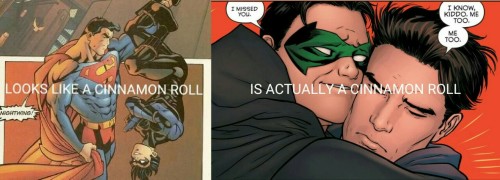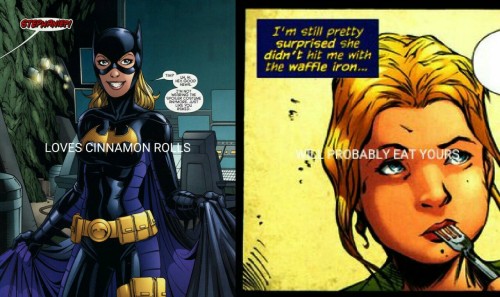I’m Sorry, Apparently I Have No Impulse Control.









I’m sorry, apparently I have no impulse control.
More Posts from Risingstarling and Others
Your Character’s Personality
Personality is the most important thing about your character.
So, whenever I see character sheets, most people just put a little paragraph for that section. If you’re struggling and don’t know what your character should say or do, what decisions they should make, I guarantee you that this is the problem.
You know your character’s name, age, race, sexuality, height, weight, eye color, hair color, their parents’ and siblings’ names. But these are not the things that truly matter about them.
Traits:
pick traits that don’t necessarily go together. For example, someone who is controlling, aggressive and vain can also be generous, sensitive and soft-spoken. Characters need to have at least one flaw that really impacts how they interact with others. Positive traits can work as flaws, too. It is advised that you pick at least ten traits
people are complex, full of contradictions, and please forgive me if this makes anyone uncomfortable, but even bullies can be “nice” people. Anyone can be a “bad” person, even someone who is polite, kind, helpful or timid can also be narcissistic, annoying, inconsiderate and a liar. People are not just “evil” or “good”
Beliefs:
ideas or thoughts that your character has or thinks about the world, society, others or themselves, even without proof or evidence, or which may or may not be true. Beliefs can contradict their values, motives, self-image, etc. For example, the belief that they are an awesome and responsible person when their traits are lazy, irresponsible and shallow. Their self-image and any beliefs they have about themselves may or may not be similar/the same. They might have a poor self-image, but still believe they’re better than everybody else
Values:
what your character thinks is important. Usually influenced by beliefs, their self-image, their history, etc. Some values may contradict their beliefs, wants, traits, or even other values. For example, your character may value being respect, but one of their traits is disrespectful. It is advised you list at least two values, and know which one they value more. For example, your character values justice and family. Their sister tells them she just stole $200 from her teacher’s wallet. Do they tell on her, or do they let her keep the money: justice, or family? Either way, your character probably has some negative feelings, guilt, anger, etc., over betraying their other value
Motives:
what your character wants. It can be abstract or something tangible. For example, wanting to be adored or wanting that job to pay for their father’s medication. Motives can contradict their beliefs, traits, values, behavior, or even other motives. For example, your character may want to be a good person, but their traits are selfish, manipulative, and narcissistic. Motives can be long term or short term. Everyone has wants, whether they realize it or not. You can write “they don’t know what they want,” but you should know. It is advised that you list at least one abstract want
Recurring Feelings:
feelings that they have throughout most of their life. If you put them down as a trait, it is likely they are also recurring feelings. For example, depressed, lonely, happy, etc.
Self Image:
what the character thinks of themselves: their self-esteem. Some character are proud of themselves, others are ashamed of themselves, etc. They may think they are not good enough, or think they are the smartest person in the world. Their self-image can contradict their beliefs, traits, values, behavior, motives, etc. For example, if their self-image is poor, they can still be a cheerful or optimistic person. If they have a positive self-image, they can still be a depressed or negative person. How they picture themselves may or may not be true: maybe they think they’re a horrible person, when they are, in fact, very considerate, helpful, kind, generous, patient, etc. They still have flaws, but flaws don’t necessarily make you a terrible person
Behavior:
how the character’s traits, values, beliefs, self-image, etc., are outwardly displayed: how they act. For example, two characters may have the trait “angry” but they all probably express it differently. One character may be quiet and want to be left alone when they are angry, the other could become verbally aggressive. If your character is a liar, do they pause before lying, or do they suddenly speak very carefully when they normally don’t? Someone who is inconsiderate may have issues with boundaries or eat the last piece of pizza in the fridge when they knew it wasn’t theirs. Behavior is extremely important and it is advised you think long and hard about your character’s actions and what exactly it shows about them
Demeanor:
their general mood and disposition. Maybe they’re usually quiet, cheerful, moody, or irritable, etc.
Posture:
a secondary part of your character’s personality: not as important as everything else. It is advised you fill this out after. Posture is how the character carries themselves. For example, perhaps they swing their arms and keep their shoulders back while they walk, which seems to be the posture of a confident person, so when they sit, their legs are probably open. Another character may slump and have their arms folded when they’re sitting, and when they’re walking, perhaps they drag their feet and look at the ground
Speech Pattern:
a secondary part of your character’s personality: not as important as everything else. It is advised you fill this out after. Speech patterns can be words that your character uses frequently, if they speak clearly, what sort of grammar they use, if they have a wide vocabulary, a small vocabulary, if it’s sophisticated, crude, stammering, repeating themselves, etc. I personally don’t have a very wide vocabulary, if you could tell
Hobbies:
a secondary part of your character’s personality: not as important as everything else. It is advised you fill this out after. Hobbies can include things like drawing, writing, playing an instrument, collecting rocks, collecting tea cups, etc.
Quirks:
a secondary part of your character’s personality, not as important as everything else. It is advised you fill this out after. Quirks are behaviors that are unique to your character. For example, I personally always put my socks on inside out and check the ceiling for spiders a few times a day
Likes:
a secondary part of your character’s personality, not as important as everything else. It is advised you fill this out after. Likes and dislikes are usually connected to the rest of their personality, but not necessarily. For example, if your character likes to do other people’s homework, maybe it’s because they want to be appreciated
Dislikes:
a secondary part of your character’s personality, not as important as everything else. It is advised you fill this out after. Likes and dislikes can also contradict the rest of their personality. For example, maybe one of your character’s traits is dishonest, but they dislike liars
History:
your character’s past that has key events that influence and shape their beliefs, values, behavior, wants, self-image, etc. Events written down should imply or explain why they are the way they are. For example, if your character is distrustful, maybe they were lied to a lot by their parents when they were a child. Maybe they were in a relationship for twenty years and found out their partner was cheating on them the whole time. If their motive/want is to have positive attention, maybe their parents just didn’t praise them enough and focused too much on the negative
On Mental and Physical Disabilities or Illnesses
if your character experienced a trauma, it needs to have an affect on your character. Maybe they became more angry or impatient or critical of others. Maybe their beliefs on people changed to become “even bullies can be ‘nice’ people: anyone can be a ‘bad’ person”
people are not their illness or disability: it should not be their defining trait. I have health anxiety, but I’m still idealistic, lazy, considerate, impatient and occasionally spiteful; I still want to become an author; I still believe that people are generally good; I still value doing what make me feel comfortable; I still have a positive self-image; I’m still a person. You should fill out your character’s personality at least half-way before you even touch on the possibility of your character having a disability or illness
Generally everything about your character should connect, but hey, even twins that grew up in the same exact household have different personalities; they value different things, have different beliefs. Maybe one of them watched a movie that had a huge impact on them.
Not everything needs to be explained. Someone can be picky or fussy ever since they were little for no reason at all. Someone can be a negative person even if they grew up in a happy home.
I believe this is a thought out layout for making well-rounded OCs, antagonists and protagonists, whether they’re being created for a roleplay or for a book. This layout is also helpful for studying Canon Characters if you’re looking to accurately roleplay as them or write them in fanfiction or whatever.
I’m really excited to post this, so hopefully I didn’t miss anything important…
If you have any questions, feel free to send a message.
- Chick



Cat Behavior


Just try not to use them all in the same paragraph. ;P









– Winners from Crunchyroll’s Anime Awards

Body Language Is More Revealing Than Words: How to Read People More Clearly
Our bodies can often be more honest than our words when it comes to communicating our thoughts, feelings, and intentions.
When we choose what to say, we’re often using the executive parts of our brains (the “neocortex”). This part of the brain is responsible for conscious attention, language, and thinking, all of which we have a degree of control over with some effort.
Because we have a choice in what we say, this makes it easier to conceal, deceive, and lie with our words.
However, we don’t usually choose our body language, which comes from the automatic parts of our brains (the “limbic system”). This part of the brain is responsible for our emotions, instincts, and gut reactions, all of which we don’t normally have control over.
According to What Every Body Is Saying: An Ex-FBI Agent’s Guide to Speed-Reading People, because our body language is more automatic than our speech, this makes it harder to conceal, deceive, and lie about our true thoughts and feelings through our bodies.
Therefore, if you want to learn how to better read people and understand what’s going on inside their minds, you need to listen more to what their bodies are communicating to you. Especially if it doesn’t match up with what they are saying.
Most of us know how to choose our words carefully. We are taught from an early age how to act polite and kind even when we don’t want to – or how to tell a harmless lie to protect someone’s feelings (“Thanks for the birthday gift! I always wanted socks!”)
However, we don’t often pay attention to what our body language is communicating. And because it happens automatically without us deliberately choosing, it’s harder to override how our body responds to a situation. Our bodies rarely lie.
In this article, I will share basic guidelines on what to look for in body language. This can also be a valuable resource in learning what your own body is communicating to others, perhaps without you even realizing it.
Click here to read more







The Justice Club
Fanart credit: Jorge Jimenez, @ohhicas, @ninalinovna, @dar-draws, @isaia, and @inkydandy.
Resources For Writing Sketchy Topics

Medicine
A Study In Physical Injury
Comas
Medical Facts And Tips For Your Writing Needs
Broken Bones
Burns
Unconsciousness & Head Trauma
Blood Loss
Stab Wounds
Pain & Shock
All About Mechanical Injuries (Injuries Caused By Violence)
Writing Specific Characters
Portraying a kleptomaniac.
Playing a character with cancer.
How to portray a power driven character.
Playing the manipulative character.
Portraying a character with borderline personality disorder.
Playing a character with Orthorexia Nervosa.
Writing a character who lost someone important.
Playing the bullies.
Portraying the drug dealer.
Playing a rebellious character.
How to portray a sociopath.
How to write characters with PTSD.
Playing characters with memory loss.
Playing a pyromaniac.
How to write a mute character.
How to write a character with an OCD.
How to play a stoner.
Playing a character with an eating disorder.
Portraying a character who is anti-social.
Portraying a character who is depressed.
How to portray someone with dyslexia.
How to portray a character with bipolar disorder.
Portraying a character with severe depression.
How to play a serial killer.
Writing insane characters.
Playing a character under the influence of marijuana.
Tips on writing a drug addict.
How to write a character with HPD.
Writing a character with Nymphomania.
Writing a character with schizophrenia.
Writing a character with Dissociative Identity Disorder.
Writing a character with depression.
Writing a character who suffers from night terrors.
Writing a character with paranoid personality disorder.
How to play a victim of rape.
How to play a mentally ill/insane character.
Writing a character who self-harms.
Writing a character who is high on amphetamines.
How to play the stalker.
How to portray a character high on cocaine.
Playing a character with ADHD.
How to play a sexual assault victim.
Writing a compulsive gambler.
Playing a character who is faking a disorder.
Playing a prisoner.
Portraying an emotionally detached character.
How to play a character with social anxiety.
Portraying a character who is high.
Portraying characters who have secrets.
Portraying a recovering alcoholic.
Portraying a sex addict.
How to play someone creepy.
Portraying sexually/emotionally abused characters.
Playing a character under the influence of drugs.
Playing a character who struggles with Bulimia.
Illegal Activity
Examining Mob Mentality
How Street Gangs Work
Domestic Abuse
Torture
Assault
Murder
Terrorism
Internet Fraud
Cyberwarfare
Computer Viruses
Corporate Crime
Political Corruption
Drug Trafficking
Human Trafficking
Sex Trafficking
Illegal Immigration
Contemporary Slavery
Black Market Prices & Profits
AK-47 prices on the black market
Bribes
Computer Hackers and Online Fraud
Contract Killing
Exotic Animals
Fake Diplomas
Fake ID Cards, Passports and Other Identity Documents
Human Smuggling Fees
Human Traffickers Prices
Kidney and Organ Trafficking Prices
Prostitution Prices
Cocaine Prices
Ecstasy Pills Prices
Heroin Prices
Marijuana Prices
Meth Prices
Earnings From Illegal Jobs
Countries In Order Of Largest To Smallest Risk
Forensics
arson
Asphyxia
Blood Analysis
Book Review
Cause & Manner of Death
Chemistry/Physics
Computers/Cell Phones/Electronics
Cool & Odd-Mostly Odd
Corpse Identification
Corpse Location
Crime and Science Radio
crime lab
Crime Scene
Cults and Religions
DNA
Document Examination
Fingerprints/Patterned Evidence
Firearms Analysis
Forensic Anthropology
Forensic Art
Forensic Dentistry
Forensic History
Forensic Psychiatry
General Forensics
Guest Blogger
High Tech Forensics
Interesting Cases
Interesting Places
Interviews
Medical History
Medical Issues
Misc
Multiple Murderers
On This Day
Poisons & Drugs
Police Procedure
Q&A
serial killers
Space Program
Stupid Criminals
Theft
Time of Death
Toxicology
Trauma











Groenendael
The Groenendael is a variety of dog that is included in the Belgian Shepherd breed, but sometimes treated as a distinct breed. The Groenendael is recognized, either as a breed or a variety of the Belgian Shepherd, by all major kennel clubs. In the American Kennel Club, it is called the Belgian Sheepdog, a term otherwise synonymous with Belgian Shepherd Dog more broadly. Like all Belgian Shepherds, the Groenendael is a medium-sized, hard-working, square-proportioned dog. The Groenendael is recognized by its distinctive black coat.
Keep reading
-
 delawyaur liked this · 2 months ago
delawyaur liked this · 2 months ago -
 midnightprocrastinator liked this · 2 months ago
midnightprocrastinator liked this · 2 months ago -
 navybrownie liked this · 5 months ago
navybrownie liked this · 5 months ago -
 normallife45 liked this · 11 months ago
normallife45 liked this · 11 months ago -
 draketim9 liked this · 1 year ago
draketim9 liked this · 1 year ago -
 pxrple-rose liked this · 1 year ago
pxrple-rose liked this · 1 year ago -
 i8aptx liked this · 1 year ago
i8aptx liked this · 1 year ago -
 evansd2-blog liked this · 2 years ago
evansd2-blog liked this · 2 years ago -
 justletthembehappyforgodssake liked this · 2 years ago
justletthembehappyforgodssake liked this · 2 years ago -
 blahwithasideofblah reblogged this · 2 years ago
blahwithasideofblah reblogged this · 2 years ago -
 liyanyus liked this · 2 years ago
liyanyus liked this · 2 years ago -
 souristhenewsweet liked this · 3 years ago
souristhenewsweet liked this · 3 years ago -
 619-funtime liked this · 3 years ago
619-funtime liked this · 3 years ago -
 theweirdlynx liked this · 3 years ago
theweirdlynx liked this · 3 years ago -
 spiderbop liked this · 3 years ago
spiderbop liked this · 3 years ago -
 chocolatelovedeer liked this · 3 years ago
chocolatelovedeer liked this · 3 years ago -
 devonaeya liked this · 3 years ago
devonaeya liked this · 3 years ago -
 beepbeepimasheep123 liked this · 3 years ago
beepbeepimasheep123 liked this · 3 years ago -
 psychopat70 liked this · 3 years ago
psychopat70 liked this · 3 years ago -
 alexxgsocial liked this · 3 years ago
alexxgsocial liked this · 3 years ago -
 noobinleaf reblogged this · 3 years ago
noobinleaf reblogged this · 3 years ago -
 noobinleaf liked this · 3 years ago
noobinleaf liked this · 3 years ago -
 mybestfriendisamoose liked this · 3 years ago
mybestfriendisamoose liked this · 3 years ago -
 jhar14 liked this · 3 years ago
jhar14 liked this · 3 years ago -
 burntjuulpod liked this · 3 years ago
burntjuulpod liked this · 3 years ago -
 naturallyathief liked this · 3 years ago
naturallyathief liked this · 3 years ago -
 cyberpilate liked this · 3 years ago
cyberpilate liked this · 3 years ago -
 izzyhaddock reblogged this · 3 years ago
izzyhaddock reblogged this · 3 years ago -
 izzyhaddock liked this · 3 years ago
izzyhaddock liked this · 3 years ago -
 redhoodsbae reblogged this · 3 years ago
redhoodsbae reblogged this · 3 years ago -
 jetblackrevival liked this · 3 years ago
jetblackrevival liked this · 3 years ago -
 batfamcraze reblogged this · 3 years ago
batfamcraze reblogged this · 3 years ago -
 sandpancakecat liked this · 3 years ago
sandpancakecat liked this · 3 years ago -
 bluepandaistiredbuthappy reblogged this · 3 years ago
bluepandaistiredbuthappy reblogged this · 3 years ago -
 bluepandaistiredbuthappy liked this · 3 years ago
bluepandaistiredbuthappy liked this · 3 years ago -
 lulidumbassvc liked this · 3 years ago
lulidumbassvc liked this · 3 years ago -
 girlwiththelionsmane reblogged this · 3 years ago
girlwiththelionsmane reblogged this · 3 years ago -
 girlwiththelionsmane liked this · 3 years ago
girlwiththelionsmane liked this · 3 years ago -
 youngjusticeslut liked this · 3 years ago
youngjusticeslut liked this · 3 years ago -
 monday-headache reblogged this · 3 years ago
monday-headache reblogged this · 3 years ago -
 monday-headache liked this · 3 years ago
monday-headache liked this · 3 years ago -
 whatever-baywatch reblogged this · 3 years ago
whatever-baywatch reblogged this · 3 years ago -
 dam-artemisdragonite liked this · 3 years ago
dam-artemisdragonite liked this · 3 years ago -
 sussux-zel liked this · 3 years ago
sussux-zel liked this · 3 years ago -
 sparethecontrition liked this · 4 years ago
sparethecontrition liked this · 4 years ago -
 crimsonaction12 liked this · 4 years ago
crimsonaction12 liked this · 4 years ago -
 shipperstyle liked this · 4 years ago
shipperstyle liked this · 4 years ago -
 hazele liked this · 4 years ago
hazele liked this · 4 years ago -
 peeveskicksass liked this · 4 years ago
peeveskicksass liked this · 4 years ago -
 sarcastielle liked this · 4 years ago
sarcastielle liked this · 4 years ago
Right now this is just anything that comes to mind since I'm a complete noob at tumblr. I've been hearing about it for years but I never really felt like I had anything to say. Well all that has changed now and I figured I'd see what all the hype about tumlr is really about. Anyway don't take anything I say too seriously for now...I'll probably change it later when I become more comfortable with this website.
168 posts